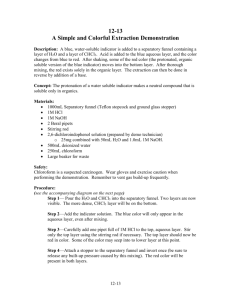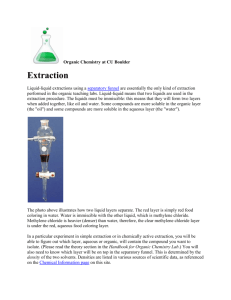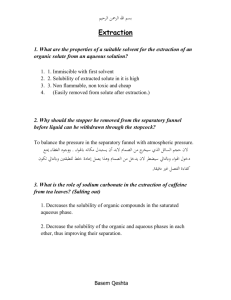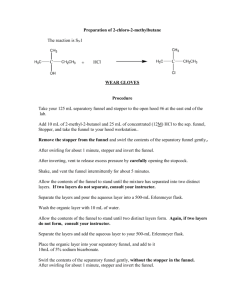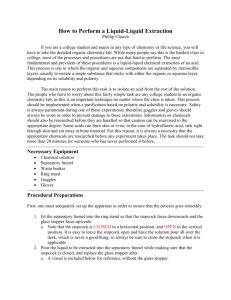Extraction in the organic chemistry teaching labs
advertisement
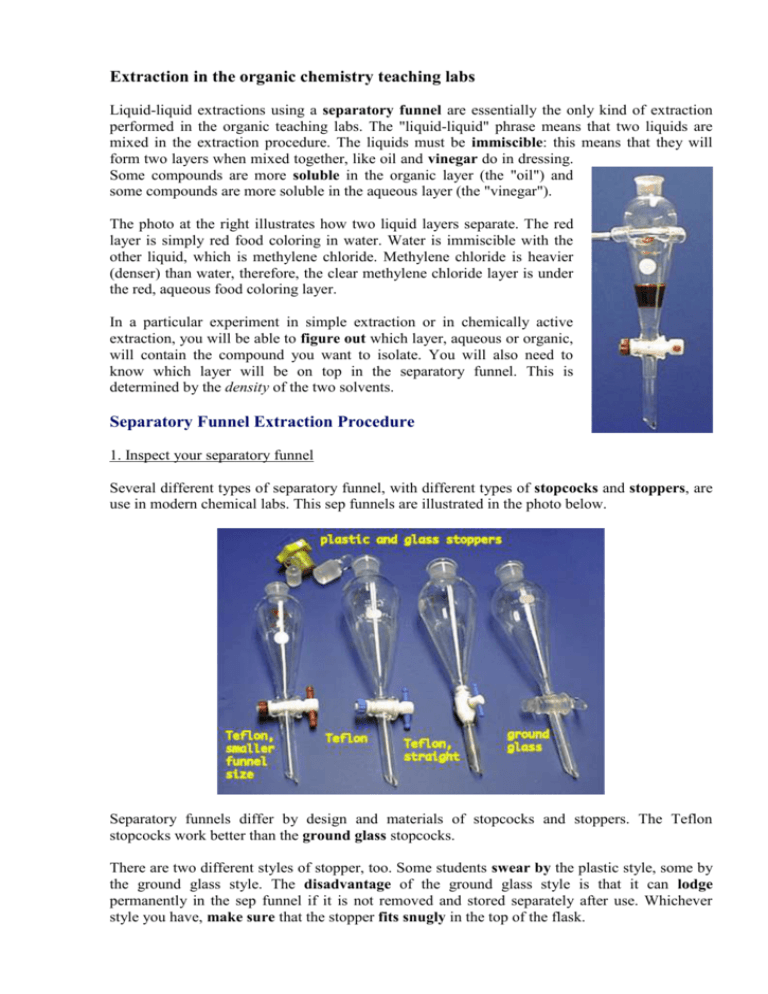
Extraction in the organic chemistry teaching labs Liquid-liquid extractions using a separatory funnel are essentially the only kind of extraction performed in the organic teaching labs. The "liquid-liquid" phrase means that two liquids are mixed in the extraction procedure. The liquids must be immiscible: this means that they will form two layers when mixed together, like oil and vinegar do in dressing. Some compounds are more soluble in the organic layer (the "oil") and some compounds are more soluble in the aqueous layer (the "vinegar"). The photo at the right illustrates how two liquid layers separate. The red layer is simply red food coloring in water. Water is immiscible with the other liquid, which is methylene chloride. Methylene chloride is heavier (denser) than water, therefore, the clear methylene chloride layer is under the red, aqueous food coloring layer. In a particular experiment in simple extraction or in chemically active extraction, you will be able to figure out which layer, aqueous or organic, will contain the compound you want to isolate. You will also need to know which layer will be on top in the separatory funnel. This is determined by the density of the two solvents. Separatory Funnel Extraction Procedure 1. Inspect your separatory funnel Several different types of separatory funnel, with different types of stopcocks and stoppers, are use in modern chemical labs. This sep funnels are illustrated in the photo below. Separatory funnels differ by design and materials of stopcocks and stoppers. The Teflon stopcocks work better than the ground glass stopcocks. There are two different styles of stopper, too. Some students swear by the plastic style, some by the ground glass style. The disadvantage of the ground glass style is that it can lodge permanently in the sep funnel if it is not removed and stored separately after use. Whichever style you have, make sure that the stopper fits snugly in the top of the flask. 2. Support the separatory funnel in a ring on a ringstand The rings are located on the back shelves and they come in many sizes. Test to make sure that you haven’t chosen too large a ring before setting the funnel in it. You can add pieces of cut elastic tubing to the ring to cushion the funnel. Make sure the stopcock of the separatory funnel is closed! 3. Add the liquid to the separatory funnel Place a stemmed funnel in the neck of the separatory funnel. Add the liquid to be extracted, then add the extraction solvent. The total volume in the separatory funnel should not be greater than three-quarters of the funnel volume. Insert the stopper in the neck of the separatory funnel. 4. Shake the separatory funnel Pick up the separatory funnel with the stopper in place and the stopcock closed, and rock it once gently. Then, point the stem up and slowly open the stopcock to release excess pressure. Close the stopcock. Repeat this procedure until only a small amount of pressure is released when it is vented. Now, shake the funnel vigorously for a few seconds. Release the pressure, then again shake vigorously. About 30 sec total vigorous shaking is usually sufficient to allow solutes to come to equilibrium between the two solvents. 5. Separating the layers Let the funnel rest undisturbed until the layers are clearly separated. While waiting, remove the stopper and place a beaker or flask under the sep funnel. Carefully open the stopcock and allow the lower layer to drain into the flask. Drain just to the point that the upper liquid barely reaches the stopcock. If the upper layer is to be removed from the funnel, remove it by pouring it out of the top of the funnel. 6. Perform multiple extractions as necessary Often you will need to do repeat extractions with fresh solvent. You can leave the upper layer in the separatory funnel if this layer contains the compound of interest. If the compound of interest is in the lower layer, the upper layer must be removed from the separatory funnel and replaced with the drained-off lower layer, to which fresh solvent is then added. Yes, it can be confusing! Plus, the beginning student often does not know in which layer resides the compound of interest. The best advice: Always save all layers until the experiment is completely finished! Questions to text 1. What does it mean the term liquid-liquid extraction? 2. What equipments use to producing liquid-liquid extraction? 3. What type of extraction you know also? 4. What does it mean immiscible liquids? 5. What factors influence on location of immiscible layers, what liquid locate in upper part of funnel and what in lower part of funnel? 6. What types of design separatory funnels are uses in modern chemical labs (9:22-11:30)? 7. Look video and tell about this types of separatory funnels? Make a comparison of they? 8. Tel about setting separatory funnel in ringstand. 9. Tel about adding liquids to the separatory funnel. 10. Tel about mixing layers in the separatory funnel. 11. Tel about separating the layers.

